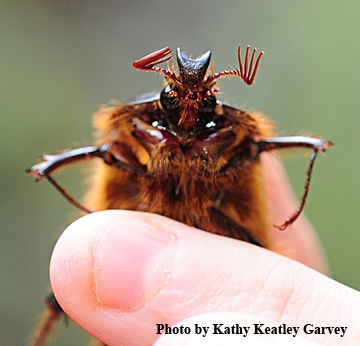- Author: Kathy Keatley Garvey

Feb. 14 was a perfect day for foragers, as the temperature climbed into the '70s, an unusually warm February day.
The site: The Glen Cove Marina in Vallejo, Calif., across the Carquinez Straits from Crockett.
We focused on one Bombus vosnesenskii--but only because the other four buzzed out of camera range. For 10 minutes, we watched her work the rosemary, buzzing from flower to flower as honey bees and syrphid flies zeroed in for their share, too.
But look at the bumble bee's pollen load, reminiscent of Halloween candy corn, those triangle-shaped yellow, orange and white-layered sweets.
"She obviously switched from one plant species with pale pollen to one with orangish pollen and maybe back again during her foraging bout," noted native polinator specialist Robbin Thorp, distinguished emeritus professor of entomology at UC Davis and co-author of California Bees and Blooms: A Guide for Gardeners and Naturalists (Heydey) and Bumble Bees of North America: An Identification Guide (Princeton University Press.)
"A fickle forager," Thorp declared. "Rosemary has whitish pollen, but it is usually a nectar resource for honey bees and others. So there must be some other plants being visited by B. vos. females in the area."
Indeed there were. California golden poppy (the state flower), wild radish, oxalis, and mustard.
"Detective" Thorp quickly figured it out. "The wild radish, mustard, and oxalis all have yellow pollen. Poppy has orange pollen. So it looks like your female may have started on rosemary (upper whitish part of the load), moved over to poppy for a while, and back to rosemary (bottom pale part of the load). Since poppy produces no nectar, visits to rosemary are primarily to tank up on nectar for flight fuel and apparently to collect some pollen there as well. It is often said that a mix of different pollen types is best for bees, so she is picking up a balanced diet for her babies."
Bottom line: When you capture an image of a bumble bee, you may not know where it's going, but a top-notch pollinator specialist can tell you where it's been!



- Author: Kathy Keatley Garvey
Honey bees aren't the only bees out foraging.
We saw our first native bee of the season on Jan. 25 at the Benicia Capitol State Historic Park.
Native pollinator specialist Robbin Thorp, distinguished emeritus professor of entomology at the UC Davis Department of Entomology and Nematology, identified it as a female sweat bee, Halictus rubicundus.
"The head shape, lack of long curled hairs below at the base of the hind leg, and the bent basal vein in the wing" helped him identify it as a Halictus. The lack of facial foveae confirmed it was not an Andrena.
"Nice early record for this species," added Thorp, who is the co-author of California Bees and Blooms: A Guide for Gardeners and Naturalists (Heydey) and Bumble Bees of North America: An Identification Guide (Princeton University Press.)
Halicutus rubicundus is found in Europe, northern Asia, and across the United States and Canada, according to the book, The Bees in Your Backyard, A Guide to North America's Bees, by Joseph S. Wilson, assistant professor of biology at Utah State University, and Olivia J. Messinger Carril, who received her doctorate in plant biology from Southern Illinois University and "has been studying bees and wasps for more than a decade," according to the publisher, Princeton University Press.
You can see more images of this sweat bee on BugGuide.Net.
So, one sweat bee down. Hundreds more to go as the seasons unfold.
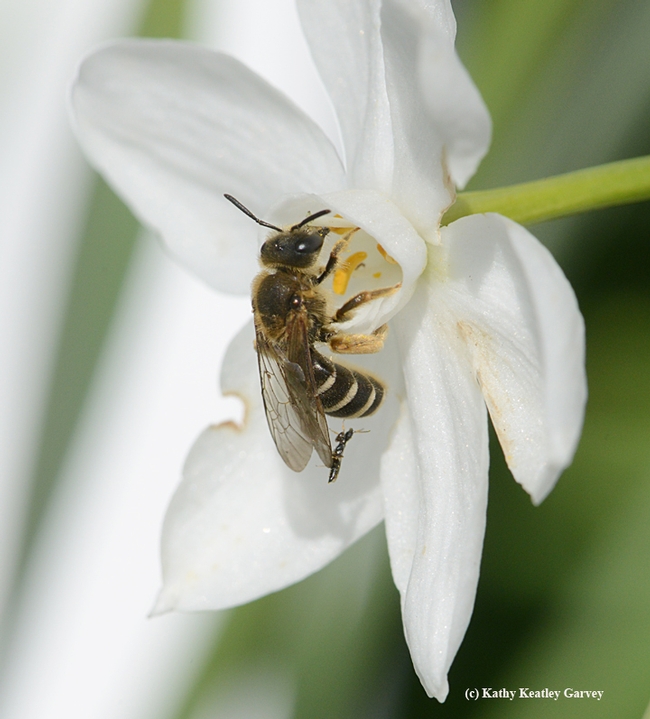

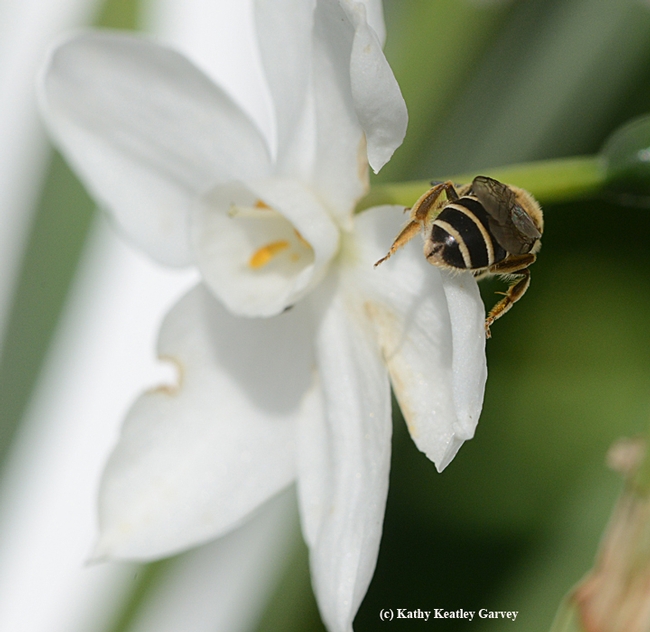
- Author: Kathy Keatley Garvey
It's good for the drought and it's good for the rain beetles.
If you've never seen a rain beetle (genus Pleocoma) no worries. Most people haven't, either. You have to be in the right place at the right time, which amounts to being in a fall or winter rainstorm in their habitat before sunrise or just after sunset. And you have to work quickly. The males can fly only a couple of hours before they die. The females are flightless.
We saw our first--and last--rain beetles back in October of 2012 when a graduate student in the UC Davis Department of Entomology and Nematology showed us several that a friend had been collected in the Shenandoah Valley of Plymouth, Amador County.
What intriguing insects! They spend most of their lives in immature stages beneath the ground, and that can total a decade or more, scientists estimate. The adults surface when the ground is soaked.
You'll never seen adult beetles eat because they don't. They have no mouthparts or digestive tracts. They rely on the fat stored from their larval stage.
The females emit a pheromone so the males can locate them. It's a hurry-hurry-hurry scenario. Arthur Evans and James Hogue, authors of Introduction to California Beetles (University of California Press, Berkeley) say that “on average, males of some rain beetles have only enough energy stored as fat to give them about two hours of air time and live only a few days. The more sedentary females require less energy and may live for months after fall and winter storms.”
In California, "Pleocoma is found only in foothill and mountain habitats, never on the valley floor that I know of,” Lynn Kimsey director of the Bohart Museum of Entomology and professor of entomology at UC Davis, told us. “A lot of the populations have been extirpated by housing developments. When I was a kid living in the Berkeley Hills in El Cerrito we had lots of males flying after every rain but once the neighborhood was built up they vanished.”
“California's rain beetles occur throughout the mountainous regions of the state, except in the deserts,” according to Evans and Hogue. Their excerpt on rain beetles is published on the website of the Hastings Natural History Reservation in Carmel, Monterey County. “Small, isolated populations also occur in the Sacramento Valley and the coastal plain of San Diego County. The known modern distribution of these apparently ancient beetles is restricted by the flightless females and is more or less correlated to areas of land that have never been subjected to glaciation or inundation by inland seas during the last two or three million years.”
As underground larvae, these insects feed on shrub and tree roots, fungi and other organic matter. Larvae can be pests when they attack the roots of apple, pear and other orchard trees.
Evans and Hogue describe the rain beetles as “large, robust, and shiny.”
And hairy. Indeed, Pleocoma is Greek for abundant hair.
“The thick layer of hair covering the undersides," they write, "is remarkably ineffective as insulation, especially for flying or rapidly crawling males who must maintain high body temperatures in cold, damp weather….the thick pile probably functions to protect both sexes from abrasion as they burrow through the soil. Males and females dig with powerful, rake-like legs and a V-shaped scoop mounted on the front of the head.”
“In most species of rain beetles, male activity is triggered by weather conditions that accompany sufficient amounts of fall or winter rainfall or snowmelt in late winter or early spring. Depending upon circumstances, males may take to the air at dawn or at dusk, or they may fly during evening showers. Others are encountered flying late in the morning on sunny days following a night of pouring rains, or during heavy snowmelt.”
Evans and Hogue say the males fly low to the ground searching for females. They are often attracted to lights (including porch lights) and pools of water. “Females crawl back down their burrows and may wait up to several months for their eggs to mature. The female eventually lays 40 to 50 eggs in a spiral pattern at the end of the burrow as much as 3 m (10 ft) below the surface. The eggs hatch in about two months.”
You can also find more information on these fascinating insects on Wikipedia, BugGuide.net, Washington State University, and YouTube, including:

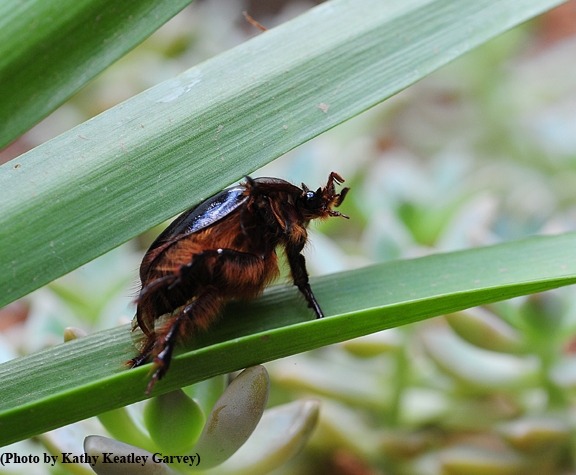


- Author: Kathy Keatley Garvey
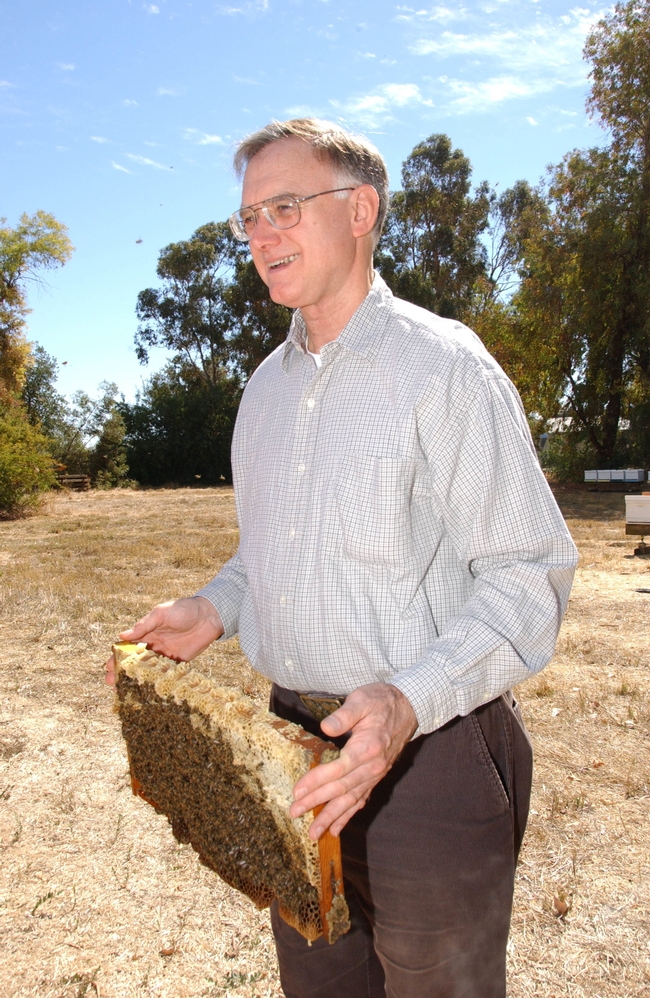
You've heard "The 12 Days of Christmas," beginning with a single "partridge in a pear tree" and ending with "12 drummers drumming." In between: two turtle doves, three french hens, four calling birds, five gold rings, six geese-a-laying, seven swans-a-swimming, eight maids-a-milking, nine ladies dancing, 10 lords-a-leaping, and 11 pipers piping.
But have you heard "The 13 Bugs of Christmas?"
Back in 2010, Extension apiculturist Eric Mussen of the UC Davis Department of Entomology (now the UC Davis Department of Entomology and Nematology) and yours truly came up with a song about "The 13 Bugs of Christmas." Presented at the Department of Entomology's holiday party, it drew roaring applause. Then U.S. News featured it when reporter Paul Bedard picked it up.
It's still making the rounds, via social media, and it's also appeared in number of pubications, including a pest control magazine.
"The 13 Bugs of Christmas" is about a psyllid in a pear tree, six lice a'laying, 10 locusts leaping and 11 queen bees piping. Beekeepers know that distinctive sound of a queen bee piping.
"We attempted to keep the wording as close as possible for ‘The 12 Bugs of Christmas' and then we opted to spotlight some new agricultural pests in the next stanza," said Mussen, who retired in June 2014 after 38 years of service.
The song:
On the first day of Christmas, my true love gave to me, a psyllid in a pear tree.
On the second day of Christmas, my true love gave to me, two tortoises beetles and a psyllid in a pear tree
On the third day of Christmas, my true love gave to me, three French flies, two tortoise beetles and a psyllid in a pear tree
On the fourth day of Christmas, my true love gave to me, four calling cicadas, three French flies, two tortoise beetles and a psyllid in a pear tree
On the fifth day of Christmas, my true love gave to me five golden bees, four calling cicadas, three French flies, two tortoise beetles and a psyllid in a pear tree
On the sixth day of Christmas, my true love gave to me six lice a'laying, five golden bees, four calling cicadas, three French flies, two tortoise beetles and a psyllid in a pear tree
On the seventh day of Christmas, my true love gave to me seven boatmen swimming, six lice a'laying, five golden bees, four calling cicadas, three French flies, two tortoise beetles and a psyllid in a pear tree
On the eighth day of Christmas, my true love gave to me eight ants a'milking, seven boatmen swimming, six lice a'laying, five golden bees, four calling cicadas, three French flies, two tortoise beetles and a psyllid in a pear tree
On the ninth day of Christmas, my true love gave to me nine mayflies dancing, eight ants a'milking, seven boatmen swimming, six lice a'laying, five golden bees, four calling cicadas, three French flies, two tortoise beetles and a psyllid in a pear tree
On the tenth day of Christmas, my true love gave to me 10 locusts leaping, nine mayflies dancing, eight ants a'milking, seven boatmen swimming, six lice a'laying, five golden bees, four calling cicadas, three French flies, two tortoise beetles and a psyllid in a pear tree
On the 11th day of Christmas, my true love gave to me 11 queen bees piping, 10 locusts leaping, nine mayflies dancing, eight ants a'milking, seven boatmen swimming, six lice a'laying, five golden bees, four calling cicadas, three French flies, two tortoise beetles and a psyllid in a pear tree
On the 12th day of Christmas, my true love gave to me 12 deathwatch beetles drumming, 11 queen bees piping, 10 locusts leaping, nine mayflies dancing, eight ants a'milking, seven boatmen swimming, six lice a'laying, five golden bees, four calling cicadas, three French flies, two tortoise beetles and a psyllid in a pear tree
Knowing the agony that Californians experience with the seemingly unending flood of pests, Mussen felt it "bugworthy" to add this verse:
"On the 13th day of Christmas, Californians woke to see:
13 Kaphra beetles,
12 Diaprepes weevils,
11 citrus psyllids,
10 Tropilaelaps clareae,
nine melon fruitflies,
eight Aedes aegypti,
seven ash tree borers,
six spotted-wing Drosophila,
five gypsy moths,
four Japanese beetles,
three imported fire ants,
two brown apple moths,
and a medfly in a pear tree."
Mussen noted that Tropilaelaps clareae is a honey bee mite from Asia, as is the well-known varroa mite (Varroa destructor), which was first detected in the United States (Wisconsin) in 1987 and is now beekeepers' No. 1 problem.
It's unlikely, however, that Tropilaelaps clareae and Varroa destructor will become part of any other Christmas song...but you never know...
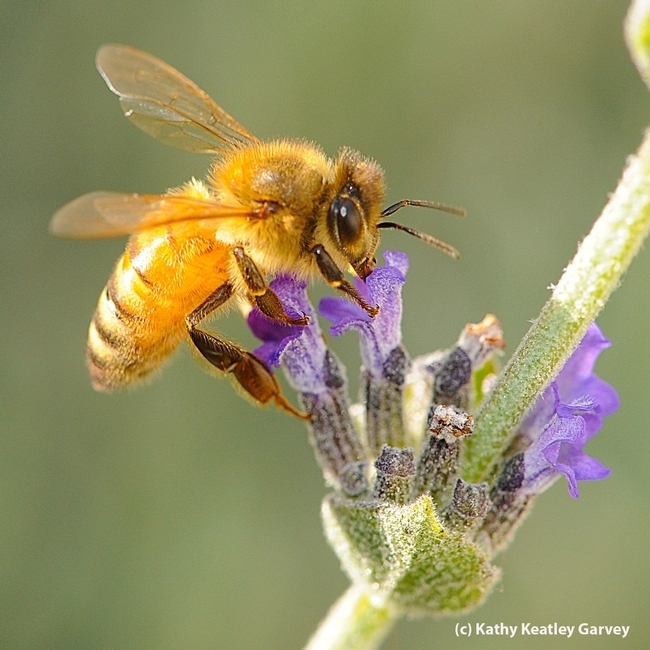
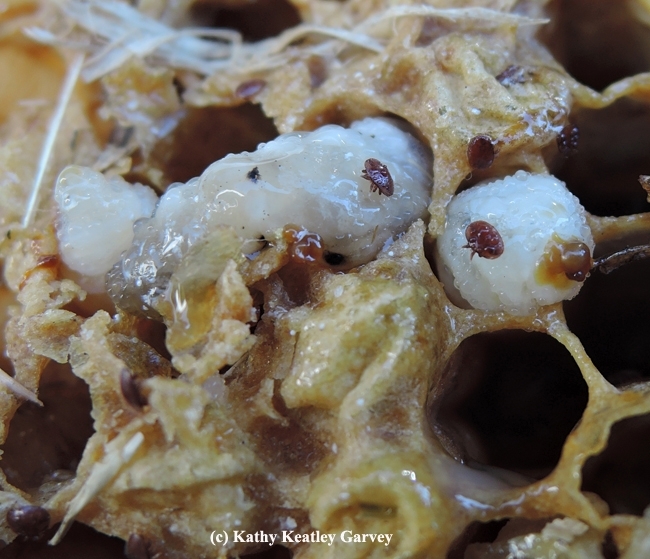
- Author: Kathy Keatley Garvey

But the Linnaean Games are also a force to be reckoned with-- for those who study insect science or who want to study insect science.
The Entomological Society of America (ESA) today posted the video of the 2015 Championship Linnaean Games on YouTube. Access it at https://youtu.be/_hA05K0NET4 to see the lively competition between the University of California, Davis and the University of Florida. UC Davis won the championship for the first time in the 32-year history of the ESA's Linnaean Games.

The UC Davis championship team was comprised of Ralph Washington Jr. and members Jessica Gillung, Brendon Boudinot and Ziad Khouri. All are graduate students in the UC Davis Department of Entomology and Nematology. They earlier won the Linnaean Games competition at the regional level: the Pacific Branch of ESA.
Washington is studying for his doctorate with major professors Steve Nadler and Brian Johnson, who respectively specialize in systematics and evolutionary biology of nematodes and the evolution, behavior, genetics, and health of honeybees; Boudinot with major professor Phil Ward, systematics and evolutionary biology of ants; and Jessica Gillung and Ziad Khouri with major professor Lynn Kimsey, who specializes in the biology and evolution of insects. Kimsey directs the Bohart Museum of Entomology.
Two members of the UC Davis Department of Entomology and Nematology faculty--Extension entomologist Larry Godfrey and Extension apiculturist Elina Niño--served as the team's advisors.
Here are some of the questions that the UC Davis team correctly answered:
Toss-Up Question: What is the smallest insect that is not a parasite or parasitoid?
Answer: Beetles in the family Ptiliidae.
Bonus Question: Some species of mosquitoes lay eggs that can undergo diapause or aestivation. Give at least three cues that trigger the aquatic eggs to hatch.
Answer: Temperature, immersion in water, concentration of ions or dissolved solutes.
Toss-Up Question: Chikungunya is an emerging vector-borne disease in the Americas. Chikungunya is derived from the African Language Makonde. What means Chikungunya in Makonde?
Answer: Bending up.
Toss-Up Question: A Gilson's gland can be found in what insect order?
Answer: Trichoptera
Toss-Up Question: Certain Chrysomelid larvae carry their feces as a defensive shield. To what subfamily do these beetles belong?
Answer: Cassidinae.
Bonus Question: The first lepidopteran sex pheromone identified was bombykol. What was the first dipteran sex pheromone identified? Give the trade or chemical name.
Answer: Muscalure, Z-9-Tricosene. It is also one of the chemicals released by bees during the waggle dance.
Toss-Up Question: What famous recessive gene was the first sex-linked mutation demonstrated in Drosophila by T.H. Morgan?
Answer: White
Bonus Question: Cecidomyiidae are known as the gall flies. What is unique about the species Mayetiola destructor, and what is its common name?
Answer: Mayetiola destructor is the Hessian Fly, a tremendous pest of wheat. It does not form galls.
Toss-Up Question: Nicrophorus americanus is listed under what legislative act?
Answer: The Endangered Species Act
Toss-Up Question: In what insect order would you find hemelytra?
Answer: The order Hemiptera.
Toss-Up Question: The subimago stage is characteristic of what insect order?
Answer: The order Ephemeroptera
Bonus Question: A 2006 Science article by Glenner et al. on the origin of insects summarized evidence that Hexapods are nothing more than land-dwelling crustaceans, which is to say that the former group Crustacea is paraphyletic with respect to the Hexapoda. What hierarchical name has been used to refer to this clade?
Answer: Pancrustacea
Toss-Up Question: What are the three primary conditions that define eusociality?
Answer: Cooperative brood care, overlapping generations, and reproductive division of labor
A total of 10 teams competed in the 2015 Linnaean Games:
- Eastern Branch: Virginia Tech University and University of Maryland
- North Central Branch: Michigan State University and Purdue University
- Pacific Branch: UC Davis and Washington State University
- Southeastern Branch: University of Georgia and University of Florida
- Southwestern Branch: Oklahoma State University and Texas A&M
The UC Davis Linnaean Games Team won the championship--they're the stars--but congratulations to all! It's a honor to be selected on a team and an honor to win a spot at the regionals and advance to the nationals.


